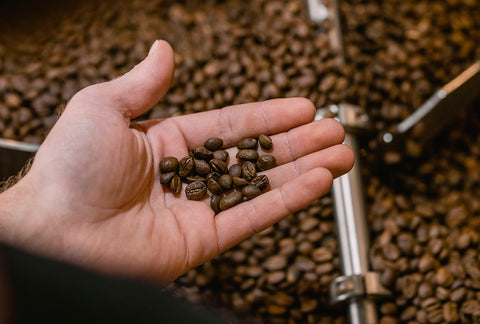
Many of us can recognize a well crafted cup of coffee, but forget to appreciate the whole process that a coffee bean must undergo in order to deliver that desired end result. Every step of coffee production is important, with the roasting process being a key element to the flavor. Roasting transforms a green coffee bean into the dark brown beans that we require to make a cup of coffee. This process brings out the aroma and flavor that are locked inside the green bean, making it a crucial step in delivering a great cup of coffee. To expand our understanding of how to create that ideal cup of coffee, we have to take a deeper look at how the coffee roasting process works.
Coffee Roasting Process
Drying Stage
Before the beans actually begin the drying stage, the roaster must be preheated in order to have a consistent coffee roasting experience. This stage is important because the moisture content that green coffee beans contain, which is around 8 to 12%, must be dried out before they can begin roasting. This process usually lasts between 4 to 8 minutes and can be done with a traditional drum roaster. If the heat is not monitored properly, the beans can burn, therefore ruining their flavor.
During the drying stage, the color of the beans change from green to yellow and there is a decrease in mass and density due to the loss of moisture. Removing the water prepares the beans for the next stages, where their flavors will be developed.
Browning Stage
As the name suggests, this is the stage in which the beans transform and turn into the brown color that we all love. The brown color stems from the caramelization that occurs due to the high temperatures. This is referred to as the Maillard Reaction, which is described as a reaction between amino acids and reducing sugars. Thanks to this reaction, coffee gains its distinct flavor and aromatic compounds.
At the end of this stage, there will be a noticeable “first crack.” This popcorn-like sound is a result of the pressure inside the coffee bean as the water turns to steam. This indicates that the next stage is ready to begin.
Development Stage
During this stage, the beans will continue caramelizing and releasing simple sugars. The length of this stage depends on the desired roast. The three main roast levels are light, medium, and dark, with each roast providing a different flavor profile. Light and medium roasts will finish soon after the first crack and before the second one. When the second crack occurs, the oils in the coffee beans start to move to the surface of the bean; dark roasts will typically be roasted past this second crack. Since the flavor of the coffee beans rely heavily on this stage, the heat and duration should be carefully monitored.
Why Is Freshly Roasted Coffee Better?

The purpose of coffee isn’t only to get an extra boost of caffeine, but also to enjoy the natural and delicious flavors that derive from coffee beans. To create a craft cup of coffee, many factors must be considered. Aside from using the proper techniques to perfectly roast the beans, the time between roasting and consumption must also be considered.
Unfortunately, the bold and delicious flavors that are created during the roasting process can decrease over time due to oxidation. When the beans come in contact with air, the oils that contribute to their flavor begin to evaporate. Ideally, grounded coffee beans will be consumed within two weeks of roasting, although they can stay fresh for longer in a closed container.
What does this mean for coffee lovers? Well, for those craving the vibrant flavors of a good cup of coffee, the roasting process and freshness can’t be ignored. At Pax, we consider the roasting process a crucial step in delivering high-quality coffee. For that reason, our new Grapevine location includes an in-house roastery to guarantee freshness and flavor in every cup of coffee.



